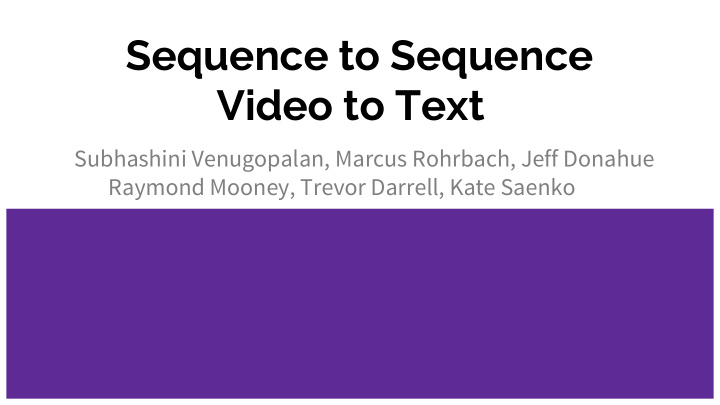



Sequence to Sequence Video to Text Subhashini Venugopalan, Marcus Rohrbach, Jeff Donahue Raymond Mooney, Trevor Darrell, Kate Saenko
Outline ● Objective ● Experimental Setup ● Current model. ● A Simple Extension. ● How is information distributed within the video ? ● Does model capture temporal information ? ● Conclusions & Future Work
Objective Generate video descriptions.
Experimental Setup Code: Forked from author’s github account Frame Sampling: 1 in 10 (unless otherwise mentioned) Network Architecture: VGG CNN + 2 layer LSTM Dataset : MSVD Youtube dataset (Avg Length 10.2 s, #sentences per video = 41) Vocabulary : MSVD + MPII-MD + MVAD Performance Metric: METEOR Evaluation Tool: coco_evaluation
Forward Model Able to learn abstract attributes like young etc to reasonable extent. ● Able to capture main content of video in most cases. ● PROBLEMS: Long sentences repeat words multiple times leading to lower quality sentences ● - The boys are playing with a group of a group of a group of people is sitting on a group of a group of people are watching a gym - A woman is cutting a piece of a piece of a pair of a pair of a pair. - A man is cutting a large of a large large large large floor.
Backward Model ● Process frames in reverse order !! ● Seems to perform better than forward model on validation set but almost similar performance on test set. ● How to choose best backward model ?
Bidirectional Model ● Motivated from Bidirectional N gram models used for Language Modelling in NLP ● Combine forward and backward models. - How do we select forward and backward model ? - Combining strategy ? - How are weights selected ?
Your description ??
FORWARD: The boys are playing with a group of a group of a group of people is sitting on a group of a group of people are watching a gym !! BACKWARD: Two boys are dancing. BIDIRECTIONAL: The boys are playing. LABEL: Three men are dancing in beach towels. This eg shows utility of Bidirectional Model.
Your description ??
FORWARD: A man is using a piece of a sharp. BACKWARD: A person is cutting a piece of a brush. BIDIRECTIONAL: A man is cutting a piece of a brush. LABEL: A person is performing some card tricks. All Fail :(
How is information distributed within video ? Conjecture: Central part of video contains more relevant information than frames at beginning and end for most videos
Does Model Capture Temporal Information ?
Conclusions ● Bidirectional model is more powerful than forward or backward model. ● Frames at start and end contain less information.
Future Work ● Try combining bidirectional with optical flow model. ● Try using gaussian sampling centred on video’s centre ● Is it more suitable for specific kinds of videos ? Like generating sports commentary ?
References Sequence to Sequence Video to Text - Subhashini Venugopalan, Marcus Rohrbach, Jeff Donahue, Raymond Mooney, Trevor Darrell, Kate Saenko
Thank You :)
Recommend
More recommend